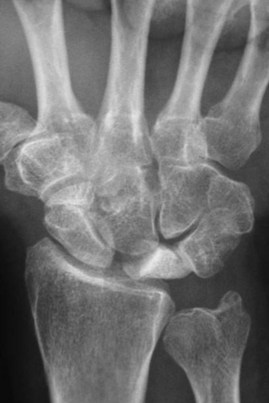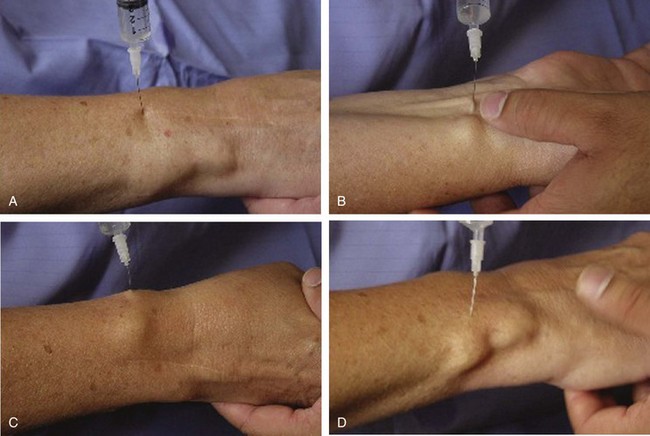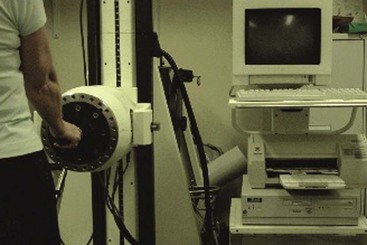Procedure 85 Wrist Denervation
Indications
 Painful arthrosis of the wrist, preservation of functional movement. Common etiologic conditions include scaphoid nonunion or scapholunate advanced collapse (SNAC/SLAC), Kienböck disease, inflammatory arthropathies, and posttraumatic arthritis following distal radius fractures or carpal dislocations.
Painful arthrosis of the wrist, preservation of functional movement. Common etiologic conditions include scaphoid nonunion or scapholunate advanced collapse (SNAC/SLAC), Kienböck disease, inflammatory arthropathies, and posttraumatic arthritis following distal radius fractures or carpal dislocations.
 Patients who require wrist motion for daily function, for example, contralateral upper extremity amputees or dependence on assistive devices for ambulation.
Patients who require wrist motion for daily function, for example, contralateral upper extremity amputees or dependence on assistive devices for ambulation.
 The patient in Figure 85-1 suffers from chronic wrist pain secondary to Kienböck disease. He is a bilateral above-knee amputee and depends on both upper extremities for ambulation.
The patient in Figure 85-1 suffers from chronic wrist pain secondary to Kienböck disease. He is a bilateral above-knee amputee and depends on both upper extremities for ambulation.
 Patient selection is controversial. Local anesthetic blocks with postinjection assessment of pain relief and functional improvement are useful in determining which patients may benefit from the procedure.
Patient selection is controversial. Local anesthetic blocks with postinjection assessment of pain relief and functional improvement are useful in determining which patients may benefit from the procedure.
Examination/Imaging
Clinical Examination
 Injection of 1 mL of bupivacaine (Marcaine) 0.5% approximately 1 cm ulnar and 3 cm proximal to the Lister tubercle has been shown to reliably deliver medication to both the posterior interosseous nerve (PIN) and the anterior interosseous nerve (AIN). The needle is inserted; when resistance of the interosseous membrane is felt, the needle is withdrawn slightly, and the medication is injected to anesthetize the PIN. Next, the needle is advanced just through the membrane, and another injection is performed to anesthetize the AIN. Blocking the AIN and PIN helps indicate whether partial denervation will be beneficial (Fig. 85-2A).
Injection of 1 mL of bupivacaine (Marcaine) 0.5% approximately 1 cm ulnar and 3 cm proximal to the Lister tubercle has been shown to reliably deliver medication to both the posterior interosseous nerve (PIN) and the anterior interosseous nerve (AIN). The needle is inserted; when resistance of the interosseous membrane is felt, the needle is withdrawn slightly, and the medication is injected to anesthetize the PIN. Next, the needle is advanced just through the membrane, and another injection is performed to anesthetize the AIN. Blocking the AIN and PIN helps indicate whether partial denervation will be beneficial (Fig. 85-2A).
 If complete denervation is planned, 1 mL of bupivacaine 0.5% is injected around the remaining nerves, including the palmar branch of the median nerve, branches of the radial nerve, the dorsal cutaneous branch of the ulnar nerve, and the recurrent intermetacarpal branches (Fig. 85-2B to D).
If complete denervation is planned, 1 mL of bupivacaine 0.5% is injected around the remaining nerves, including the palmar branch of the median nerve, branches of the radial nerve, the dorsal cutaneous branch of the ulnar nerve, and the recurrent intermetacarpal branches (Fig. 85-2B to D).
 After injection, pain is expected to be diminished considerably, and work output should at least double.
After injection, pain is expected to be diminished considerably, and work output should at least double.
 A Baltimore Therapeutic Equipment (BTE) Work Simulator (Fig. 85-3) can be used to assess work function before and after bupivacaine injection. Functional assessment provides the most accurate prediction of success following wrist denervation and provides the patient with a good idea of what to expect after surgery.
A Baltimore Therapeutic Equipment (BTE) Work Simulator (Fig. 85-3) can be used to assess work function before and after bupivacaine injection. Functional assessment provides the most accurate prediction of success following wrist denervation and provides the patient with a good idea of what to expect after surgery.
Exposures
 For partial denervation (PIN and AIN), a single longitudinal or transverse dorsal incision is used. Beginning about 2 cm proximal to the ulnar head, a 2- to 3-cm incision is made over the interval between the distal radius and ulna. The deep antebrachial fascia is incised longitudinally, exposing the extensor pollicis longus (third compartment) and extensor digitorum communis (fourth compartment) (Fig. 85-4).
For partial denervation (PIN and AIN), a single longitudinal or transverse dorsal incision is used. Beginning about 2 cm proximal to the ulnar head, a 2- to 3-cm incision is made over the interval between the distal radius and ulna. The deep antebrachial fascia is incised longitudinally, exposing the extensor pollicis longus (third compartment) and extensor digitorum communis (fourth compartment) (Fig. 85-4).
 Full denervation can be done through four incisions. Incision 1: A transverse incision is made 3 to 5 cm proximal from the wrist on the dorsal forearm (Fig. 85-5
Full denervation can be done through four incisions. Incision 1: A transverse incision is made 3 to 5 cm proximal from the wrist on the dorsal forearm (Fig. 85-5
Stay updated, free articles. Join our Telegram channel

Full access? Get Clinical Tree









